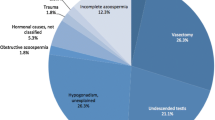Abstract
Purpose: To optimize the use of fresh and frozen-thawed testicular biopsy specimens from patients with azoospermia.
Methods: Fifty-one patients suffering from obstructive and non-obstructive azoospermia underwent testicular sperm extraction (TESE). The specimens were divided and used for either in vitro maturation or freezing for a future intracytoplasmic sperm injection (ICSI) cycle.
Results: At initial testicular sperm extraction, very few motile spermatozoa were seen. After 24 h of in vitro maturation, sperm motility increased remarkably, with a maximum motility rate seen between 48 and 72 h of culture. Motile spermatozoa were observed up to 120 h in culture. In the 22 fresh ICSI cycles, a total of 294 oocytes were injected using motile sperm and 212 oocytes demonstrated normal 2PN formation (fertilization rate, 72.1%). In 36 frozen-thawed ICSI cycles, a total of 454 oocytes were injected and 302 oocytes became 2PN (66.5%). On day 3, high quality embryos were observed in 54.2% of fresh cycles and 54.1% of frozen cycles (P > 0.05). The clinical pregnancy rate did not show a significant difference between using fresh (59%) and frozen (55.5%) testicular biopsy sperm for ICSI (P > 0.05), but the embryo implantation rates did differ significantly between fresh (29.5%) and frozen-thawed (22.2%) cycles (P < 0.05). A total of 33 healthy babies have been born from 22 women, giving birth after 58 embryo transfer attempts (38%).
Conclusion: The freezing and in vitro culturing of testicular biopsy tissue is a very reliable approach for the management of testicular biopsy specimens from azoospermic patients, and offers the possibility of several treatments of IVF/ICSI from a single sample.
Similar content being viewed by others
References
Palermo G, Cohen J, Alikani M, Alder A, Rosenwaks Z: Intracytoplasmic sperm injection: A novel treatment for all forms of male infertility. Fertil Steril 1995;63:1231–1245
Romero J, Remohi J, Minguez Y, Rubio C, Pellicer A, Gil-Salom M: Fertilization after intracytoplasmic sperm injection with cryopreserved testicular spermatozoa. Fertil Steril 1996;65:877–879
Angelopoulos T, Adler A, Krey L, Licciardi F, Noyes N, McCullough A: Enhancement or initiation of testicular sperm motility by in vitro culture of testicular tissue. Fertil Steril 1999;71:240–243
Emiliani S, Van den Bergh M, Vannin A, Biramane J, Verdoodt M, Englert Y: Increased sperm motility after in vitro culture of testicular biopsies from obstructive azoospermic patients results in better post-thawed recovery rate. Hum Reprod 2000;12:2371–2374
Pasqualotto F, Rossi-Ferragut R, Rocha C, Iaconelli A, Borges E: Outcome of in vitro fertilization and intracytoplasmic injection of epididymal and testicular sperm obtained from patients with obstructive and non-obstructive azoospermia. J Urol 2002;167:1753–1756
Schoor R, Elhanbly S, Niederberger C, Ross L: The role of testicular biopsy in the modern management of male infertility. J Urol 2002;167:197–200
Jow WW, Steckel J, Schelgel PN, Magid MS, Goldstein M: Motile sperm in human testis biopsy specimen. J Androl 1993;14:194–198
Lacham-Kaplan O, Trounson A: The effects of the sperm motility activators 2-deoxyadenosine and pentoxifylline used for sperm microinjection on mouse and human embryo development. Hum Reprod 1993;8:945–952
Nagy Z, Liu J, Cecile J, Silber S, Devroey P, Van Steirteghem A: Using ejaculated, fresh, and frozen-thawed epididymal and testicular spermatozoa gives rise to comparable results after intracytoplasmic sperm injection. Fertil Steril 1995;63:808–815
Liu J, Tsai Y, Katz E: Outcome of in vitro culture of fresh and frozen thawed human testicular spermatozoa. Hum Reprod 1997;12:1667–1672
Craft I, Tsirigotis M, Zhu J: In vitro culture of testicular sperm (letter). Lancet 1995;346:1439
Zhu J, Tsirigotis M, Pelelcamos M: In vitro maturation of human testicular spermatozoa. Hum Reprod 1996;11:231–232
Liu J, Garcia E, Baramki A: The difference in outcome of in vitro culture of human testicular spermatozoa between obstructive and non-obstructive azoospermia. Hum Reprod 1996;11:1587–1588
Allan J, Cotman A: A new method for freezing testicular biopsy sperm: Three pregnancies with sperm extracted from cryopreserved sections of seminiferous tubule. Fertil Steril 1997;68:741–744
Friedler S, Raziel A, Soffer Y, Strassburger D, Komarovsky D, Ron-El R: Intracytoplasmic injection of fresh and cryopreserved testicular spermatozoa in patients with non-obstructive azoospermia—A comparative study. Fertil Steril 1997;68:892–897
Grabbe E, Verheyen G, Taureye H, Van Steirteghem A: Freezing of testicular tissue as a minced suspension preserves sperm quality better than whole-biopsy freezing when glycerol is used as cryoprotectant. Int J Androl 1999;22:43–48
Park YS, Lee SH, Song SJ, Jun JH, Koong MK, Seo JT: Influence of motility on the outcome of in vitro fertilization/intracytoplasmic sperm injection with fresh vs. frozen testicular sperm from men with obstructive azoospermia. Fertil Steril 2003;80:526–530
Aoki VW, Wilcox AL, Thorp C, Hamilton BD, Carrell DT: Improved in vitro fertilization embryo quality and pregnancy rates with intracytoplasmic sperm injection of sperm from fresh testicular biopsy samples vs. frozen biopsy samples. Fertil Steril 2004;82:1532–1535
Thompson-Cree MEM, McClure N, Donnelly Eilish T, Steele Kristine E, Lewis Sheena EM: The effects of cryopreservation on testicular sperm nuclear DNA fragmentation and its relationship with assisted conception outcome following intracytoplasmic sperm injection. Reprod Biomed Online 2003;7(4):449–455
Anderson AR, Wiemer KE, Weikert ML, Kyslinger ML: Fertilization, embryonic development and pregnancy losses with intracytoplasmic sperm injection for surgically-retrieved spermatozoa. Reprod Biomed Online 2002;5(2):142–147
Said TM, Agarwal A, Sharma RK, Thomas AJ Jr, Sikka SC: Impact of sperm morphology on DNA damage caused by oxidative stree induced by beta-nicotinamide adenine dinucleotide phosphate. Fertil Steril 2005;83:95–103
Author information
Authors and Affiliations
Corresponding author
Additional information
Presented in part at the 51st Annual of Pacific Coast Reproductive Society, April 23–27, 2003, Rancho Mirage, California.
Rights and permissions
About this article
Cite this article
Wu, B., Wong, D., Lu, S. et al. Optimal use of fresh and frozen-thawed testicular sperm for intracytoplasmic sperm injection in azoospermic patients. J Assist Reprod Genet 22, 389–394 (2005). https://doi.org/10.1007/s10815-005-7481-y
Received:
Accepted:
Issue Date:
DOI: https://doi.org/10.1007/s10815-005-7481-y




